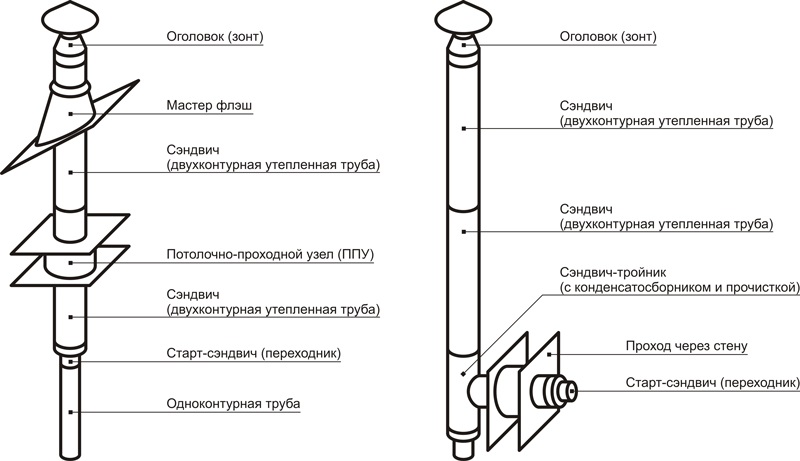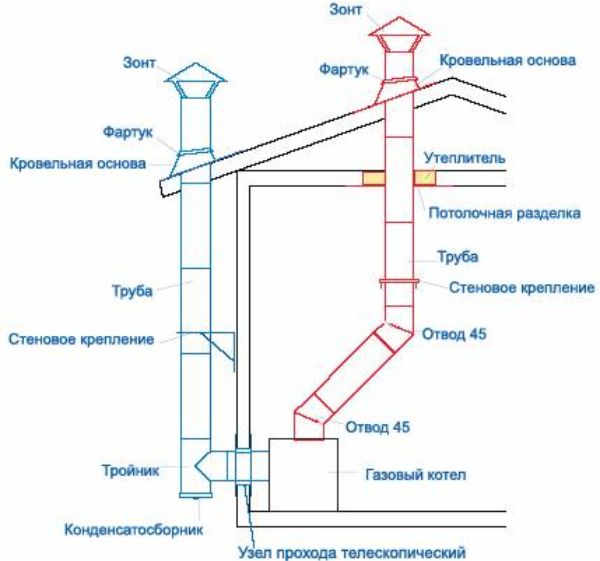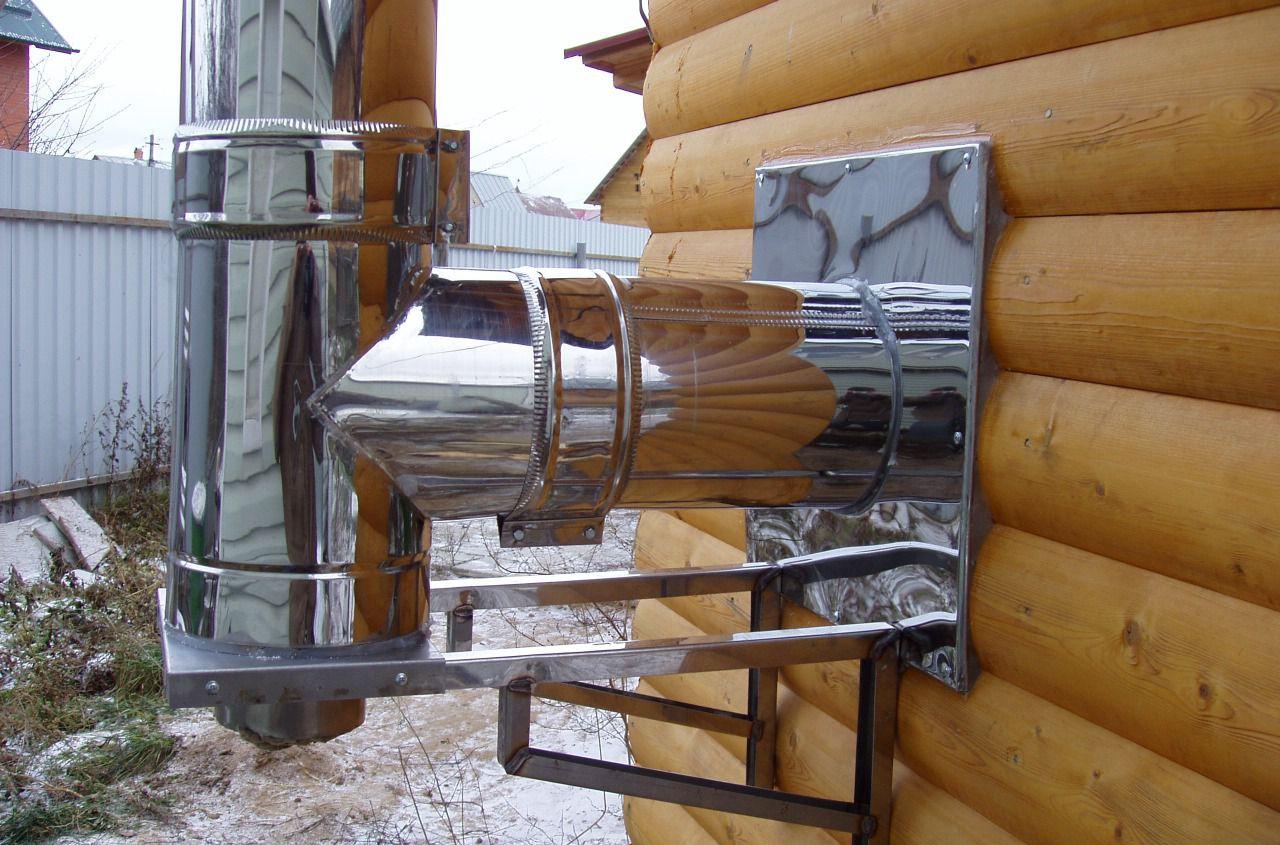Installation of chimneys is the main thing that needs to be done after their purchase. The correct installation of the chimney will determine the efficiency of the entire flue system. If everything is done correctly, then, subsequently, you can not worry about incorrectly installed elements, which can cause a fire.
One of the most effective today can be considered a thermally insulated insulated chimney, which is also called a "sandwich". Condensate does not accumulate in its pipes, even if they are subjected to great heat, and there is practically no soot deposits. This means that it can be cleaned less frequently, while the life of such a chimney can be decades.
How many types of chimneys exist, as many, probably, there are options for connecting it. Anyway, the main thing that you need to remember when connecting the chimney is that it is imperative to observe safety precautions and follow the standards that are prescribed in GOST and various SNIPs.
Content
Checking chimneys for malfunctions
Preventive work on checking and cleaning chimneys should be carried out only by persons holding a special license, which is issued by the Ministry of Emergencies. At the same time, the owner of the building should be present, and if this is not possible, then the representative of the organization that is responsible for the engineering support of the buildings being inspected.
Proper operation of the chimney means that it has good draft, there are layers of thermal insulation, and also it meets all the necessary requirements in the field of fire safety.
A chimney survey is based on the following:
- a thorough inspection of the entire chimney for various types of blockages (the chimney must have good draft);
- checking the correct installation of the entire structure.
If the examination was successful, then after a thorough check, a conclusion is issued on its suitability for work.
Chimney installation rules
There are different ways to position chimneys. One of the most common is the installation on the external walls of houses. Often this is how a chimney is installed if the heating boiler or stove itself is already in the house. If an external chimney is mounted, then it must be carried out through the entire ceiling of the wall.
There is a certain order of how to make a chimney. First of all, installation work must begin near the heating source. As for the diameter of the entire chimney, special attention must be paid to this. Here it is necessary to take into account all the features of the heating unit, as well as follow all the manufacturer's recommendations. But the main rule that you need to remember is that the size of the chimney pipe should not be smaller than the outlet on the boiler or furnace.

If you are installing chimneys with difficulties, then you can connect using special taps or tees.
You also need to have a certain set of elements for installing the chimney indoors. The number of these elements may depend on how the nozzle is located. It can have both an upper location and a side one. And of course, you need to consider where the smoke channel is directed. It can be located at a certain angle or strictly vertical, and there are designs and with a rotation by a certain number of degrees.
The pipe in the overlap must be carried out using a special passage pipe, while it is imperative to use an insulation layer that prevents ignition. Where the chimney passes through the wall, it is best not to dock the chimney elements.

It is best not to make the horizontal sections of the chimney too large, as this can reduce draft. And if you can’t do without it, then do not make this segment more than one meter.
If it is planned to conduct steel chimneys along the outer walls of the building, then it is better to use the double-walled version by performing a careful transition to the single-walled, which is located indoors.
To solve the problem of how to make a chimney in a vertical arrangement from a horizontal view, you need to use special tees. For a more convenient use of the chimney, it is worth equipping it with audit elements. The chimney, installed where there is a large flow of people, it is better to protect the fence from passing passers-by.
Installation of chimneys (pipe sandwich) is carried out by inserting one pipe into another. In this case, the docking points must be fixed with a clamp.
The distance between the brackets for fixing the pipes to the wall should be about two meters. In this case, the brackets must be mounted so that in between the pipes there is no deflection.
When all installation work is completed, check the draft in the chimney. It is easy to do. It is necessary to light a candle and bring it to the bottom of the chimney. If the flame begins to deviate noticeably towards the chimney, then there is draft.
How to make a chimney for a gas boiler or column, or rather, how to connect it? We will talk about this later.
How to connect a chimney to a boiler or gas column?
Best of all, if the chimney system will be equipped with a special device for condensate drain (if we are talking about a gas column). It is enough to say only that during the combustion of approximately 1 cubic meter of gas, up to 3 liters of condensate can form. Usually, when the installation of chimneys is carried out, such a system is constructed immediately that discharges condensate into the sewer, while corrugated pipes are used.

If the chimney is made for a diesel unit, then the pipe must be made of stainless steel. After all, it must meet the requirements of resistance to acid, which can be formed during the combustion of diesel fuel.
For a chimney that has multiple bends, you need to carefully calculate the draft.
Installation of chimneys for stoves and fireplaces
More recently, a chimney made of bricks was more often installed for stoves and fireplaces, and today the best recommendation would be to use a sandwich chimney or two-layer, because the pipes of such chimneys have a very high temperature of the outgoing smoke. You can also use heat-insulating materials, while the thickness of the heat-insulating layer should not be less than one hundred millimeters.
If the chimney is additionally sheathed to give it a nice look, then in this case it is necessary that in the final version ventilation grilles are made that will help the air circulate to prevent overheating.
The upper part of the chimney system must be carefully protected from precipitation, for this you need to use an “umbrella”, and also, if necessary, a deflector. The deflector also has the advantage that it can significantly help increase traction (especially in strong winds), but at the same time it will prevent the occurrence of a phenomenon such as reverse traction (blowing wind into the pipe).
It is imperative to indent from the wall and other ceilings during the passage of the chimney, especially with regard to the roof of the building. If the pipe has layers of insulation, then this gap can be small, only 150 millimeters.But for pipes that do not have insulation, the gap should be significantly increased, up to 300 millimeters and even higher.
In order to improve the waterproofing properties of the chimney and with the complex structure of the roof, you can apply a covering sheet from the place where the chimney passes through the roof and up to the ridge.
Requirements for a coaxial chimney for installation on gas appliances
First of all, you need to understand what a coaxial chimney is. In short, this design can be called "one pipe is in another pipe." These steel chimneys are very different from the rest in that part of the air for better ignition is taken with the help of fans not from the inside, but from the outside.
Here are the basic rules, the implementation of which requires the high-quality installation of chimneys on gas appliances:
- in such a chimney drain for accumulated condensate is mandatory;
- fixing at the top of the chimney a special tip "torch";
- the use of only those types of steel that are protected against the effects of acids.
But the installation of chimneys of this type has some nuances that must be taken into account. In order to make correct calculations for the passage of the chimney pipe, it is necessary to take into account not only the design features of the equipment, but also thoroughly examine the territory on which this chimney will be installed. The chimney pipe must be positioned so that air enters it without interference, and the burner does not die out, but continues to burn.
Of course, it is simply impossible to cover all the nuances for various types of heating units in one article, but using the tips and recommendations of this article, you can make the installation of the chimney safer and more reliable!





Alas, no comments yet. Be the first!